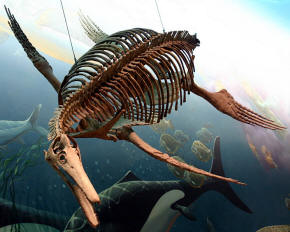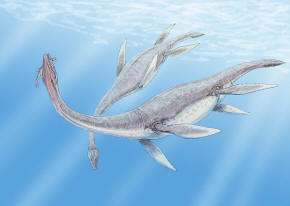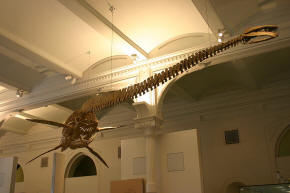|
The first plesiosaur skeletons were
found in England by
Mary Anning, in the
early 19th century, and were amongst the first fossil vertebrates to be
described by science. Many museums all over the globe have plesiosaur
specimens.
Plesiosaurs had a broad body and a
short tail. They retained
their ancestral two pairs of
 |
| Dolichorhynchops, a short-necked, long-jawed plesiosaur,
National Museum of Natural History, Washington D.C. (Picture
Source) |
limbs, which evolved into large flippers.
It has been determined by teeth records that several
sea-dwelling reptiles, including Plesiosaurs, had a warm-blooded metabolism
similar to that of mammals. They had the ability to generate endothermic
heat to survive in colder habitats.
Evolution
Plesiosaurs evolved from earlier,
similar forms such as
pistosaurs or very
early, longer-necked
pliosaurs. There are a
number of
families of
plesiosaurs, which retain the same general appearance and are distinguished
by various specific details. These include the
Plesiosauridae,
unspecialized types which are limited to the
Early Jurassic period;
Cryptoclididae, (e.g.
Cryptoclidus), with a
medium-long neck and somewhat stocky build;
Elasmosauridae, with
very long, inflexible necks and tiny heads; and the
Cimoliasauridae, a
poorly known group of small Cretaceous forms. According to traditional
classifications, all plesiosaurs have a small head and long neck but, in
recent classifications, one short-necked and large-headed Cretaceous group,
the
Polycotylidae, are
included under the Plesiosauroidea, rather than under the traditional
Pliosauroidea. Size of different plesiosaurs varied significantly, with an
estimated length of
Trinacromerum being
three meters and
Mauisaurus growing to
twenty meters.
Behavior
Unlike their pliosaurian cousins,
plesiosaurs (with the exception of the Polycotylidae) were
 |
| Restoration of a Plesiosaurus dolichodeirus pair, one
catching a fish (Picture
Source) |
probably slow
swimmers. It is likely that they cruised slowly below the
surface of the water, using their long flexible neck to move their head into
position to snap up unwary fish or
cephalopods. Their
four-flippered swimming adaptation may have given them exceptional
maneuverability, so that they could swiftly rotate their bodies as an aid to
catching prey.
Contrary to many reconstructions of
plesiosaurs, it would have been impossible for them to lift their head and
long neck above the surface, in the "swan-like"
pose that is often shown. Even if they had
been able to bend their necks upward to that degree (which they could not),
gravity would have tipped their body forward and kept most of the heavy neck
in the water. Most famous of these poses is the ones that portray the
mythical Loch Ness Monster.
The series
Walking with Dinosaurs
shows the plesiosaur
Cryptoclidus hauling
out on land like a
sea lion.
Return to the
Old Earth Ministries Online Dinosaur
Curriculum homepage.

|


